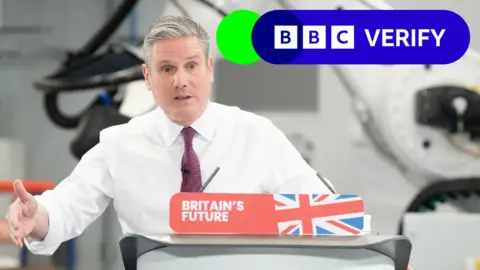What happened to Labour’s £28bn for green projects?
 EPA-EFE/REX/Shutterstock
EPA-EFE/REX/ShutterstockLabour has announced that it will no longer spend £28bn a year on environmental projects if it wins the upcoming general election.
The "green economy" plan has gone through various changes since it was first announced in 2021.
What is the plan now?
Labour leader Sir Keir Starmer confirmed the party has "stood down" its pledge to invest £28bn a year on green policies, blaming the "damage the Tories have done to the economy".
Speaking to the BBC, Sir Keir said Labour would stick to other green commitments, including: battery factories, wind farms with British-made turbines, more environmentally-friendly steel production and the clean energy company GB Energy.
And the party has still pledged to generate all the UK's electricity without increasing the amount of greenhouse gases in the atmosphere by 2030.
But the plan to make homes more energy-efficient with things like better insulation will be slowed down.
What was the £28bn plan?
The plan was first announced in September 2021, when shadow chancellor Rachel Reeves said Labour would put £28bn every year of this decade towards the transition to a green economy.
Ms Reeves said the Green Prosperity Plan would create "good new jobs in communities throughout Britain" and "protect our planet".
It was warmly welcomed at the Labour Party conference.
How did it change?
In June 2023, Ms Reeves said the £28bn would not be spent on day one of a Labour government because of the poor economic picture and the soaring cost of borrowing.
The party decided the amount would be increased over time, reaching £28bn per year in the second half of the next parliament, which would be after 2027.
Then in January 2024, Sir Keir said Labour would spend less if the amount of borrowing needed would break its self-imposed fiscal rules. These include a pledge that government debt should be on course to fall as a share of the size of the economy in five years.
And the party said that every pound invested by the government in clean energy production would have to be matched by £3 of private investment.
Also, the amount extra to be invested was reduced by government announcements such as around £8bn of future climate-related investment and pledged another £2bn of investment in the hydrogen industry.
That implies Labour would not have to spend as much as an extra £28bn a year.
But as recently as 6 February, Sir Keir was still using the £28bn figure, telling Times Radio: "we're going to need investment - that's where the 28 billion comes in".
What have the Conservatives said?
The government has repeatedly criticised Labour's plan.
Prime Minister Rishi Sunak has said it would "push up inflation" and would be a "£28bn spending spree", claiming that taxes would need to rise to fund it.
On 7 February, the government published an analysis of part of the plan to improve home energy efficiency, which suggested it would cost much more than planned.
But the analysis assumed that all of the work would be government-funded and that there would be no cap on annual spending. Labour rejected the analysis as "bogus".
The Conservative account on X put out a 311 tweet thread on 8 February with all the times the £28bn had been mentioned.


